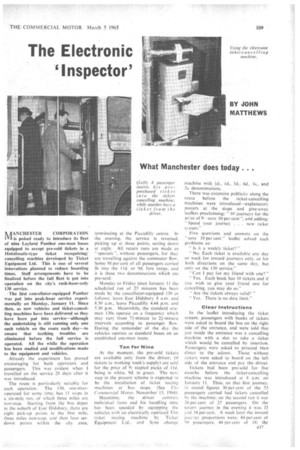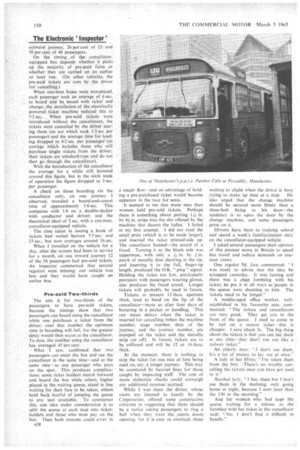The Electronic Inspector'
Page 111

Page 112

If you've noticed an error in this article please click here to report it so we can fix it.
BY JOHN MATTHEWS
What Manchester does today ,
AANCHESTER CORPORATION in is poised ready to introduce its fleet of nine Leyland Panther one-man buses equipped to accept pre-sold tickets in a Holstirnatic-type ticket recognizing/ cancelling machine developed by Ticket Equipment Ltd. This is one of several innovations planned to reduce boarding
Staff arrangements have to be finalized before the full fleet is put into operation on the city's rush-hour-only 130 service.
The first cancellator-equipped Panther was put into peak-hour service experimentally on Monday, January 11. Since then, as new vehicles and ticket-cancelling machines have been delivered so they have been put into service—although the underlaking is still running only one such vehicle on the route each day—to ensure that teething troubles are eliminated before the full service is operated. MI the while the operation has been studied and modifications made to the equipment and vehicles.
Already the experiment has proved encouraging for both operators and passengers. This was evident when I travelled on the service 28 days after it was introduced,
The route is particularly suitable for such operation. The 130, one-Manoperated for some time, has 11 stops in a six-mile rim, of which three miles are non-stop. Starting from the bus depot in the suburb of Fast Didsbury, there are eight pick-up points in the first mile, three miles non-stop, and then four setdown points within the city area.
terminating at the Piccadilly centre. In the evening. the service is reversed. picking up at three points, setting down at eight. All return runs are made as " specials", without passengers, for they are travelling Against the commuter flow. Some 98 per cent of all passengers carried fit into the lid, or 9d. fare range. and it is these two denominations which are pre-sold.
Monday to Friday since January 11 the scheduled run of 25 minutes has been made by the cancellator-equipped 130 as follows: leave East Didsbury 8 a.m. and 8.50 a.m., leave Piccadilly 4.44. p.m. and 5.30 p.m. Meanwhile, the standard oneman 130soperate on a frequency which may vary from 71-minute to 2frnintite intervals according to passenger flow. During the remainder of the day the vehicles operate as standard buses on an established one-man route.
Ten for Nine
At the moment, the pre-sold tickets are available only from the driver; 10 tickets (a working week's supply) are sold for the price of 9; stapled packs of 11d. being in white, 9d. in green. The next step in the present scheme is expected to be the installation of ticket issuing machines at bus stops. (See The Commercial Motor, November 13, 1964).
Meantime, the driver controls individual fares and his handling time has been speeded by equipping the vehicles with an electrically operated Tim ticket issuing machine by Ticket Equipment Ltd., and Syro change machine With RI., Id., 3d., 6d., Is., and 2s. denominations.
There' was extensive publicity along the route before the ticket-cancelling machines were introduced--explanatory posters at the stops and give-away leaflets proclaiming: " 10 journeys for the pr:ce of 9--save 10 per cent ", and adding: " Speed your journey . . . new ticket system."
Five questions and answers on the "save 10 per cent" leaflet solved such problems as: " Is it a weekly ticket? "
" No. Each ticket is available any day or week for inward journeys only, or for both directions on the same day, but only on the 130 service."
"Can I pay for my friend with one?"
" Yes. Each book has 10 tickets and if you wish to give your friend one for cancelling, you may do so."
" Are the tickets always valid? "
" Yes. There is no date limit."
Clear Instructions
In the leaflet introducing the ticket system, passengers with books of tickets were asked to board the bus on the right side of the entrance, and were told that Just inside the entrance was a cancelling machine with a slot to take a ticket which would he cancelled by insertion. Passengers were asked to proceed then direct to the saloon. Those without tickets were asked to board on the left side of the entrance and pay the driver.
Tickets had been pre-sold for five months before the ticket-cancelling machine was introduced at 8 a.m. on January 11. Thus, on that first journey. in round. figures 30 per cent of the 53 passengers carried had tickets cancelled by the machine; on the second run it was 36 per cent of 25 passengers. On the return journey in the evening it was 33 and 34 per cent. A week later the inward jouuey proportions were: 44 per cent of 50 passengers. 44 Der cent of 18; the
outward journey, 26 per cent of 23 and 50 per cent of 46 passengers.
On the timing of the cancellatorequipped bus depends Whether it picks up the majority of pre-paid fates or whether they are carried on an earlier or later run. (On other vehicles.' the pre-paid tickets are torn by the driver for: cancelling.)
When one-man buses were introdticed, each passenger took an average of 6 sec. to board and be issued with ticket' and change; the installation of the electrically powered'. ticket machine reduced this to 5-2 sec. When pre-sold tickets Were introduced without the cancellators. the tickets were cancelled by the driver tear-. ing them (an 'act which took 1.3 sec per passenger) And the average time for loading dropped to. 4-2 sec. per passenger' fail ave./4e Which includes those who still purchase single tickets_ from the driver; their tickets are standard-type and do not then go through the cancellator).
r With the introduction of the cancellator the average for a while still, hovered around this figure, but in the sixth week of operation the figure dropped to 3 sec. per passenger.
A cheek on those boarding via the cancellator only, on one journey I observed, revealed a hoard-and-cancel time of approximately 1.6 sec. This compares with 1.8 on a double-decker with conductor and driver; and the theoretical ideal of 2 sec. with a one-Man, cancellator-equipped vehicle.
The time taken in issuing a book of tickets had varied betwen 5.5 sec. and 23 sec., but now averages around 16 sec.
When 1 travelled on the vehicle for a day, after the system bad been in service for a month, on one inward journey 12 of the 54 passengers had pre-sold tickets. An inspector commented that several regulars were missing; our vehicle was late and they would have caught an earlier bus.
Pre-sold Two-thirds The aim is for two-thirds of the passengers to have pre-sold tickets, because the timings show that two passengers can board using the cancellator while one purchases a ticket from the driver; over that number the optimum time in boarding will fall, for the greater delay would then occur. at.the cancellator. To date, the number using the cancellator has averaged 45 per cent.
What -1 saw. confirmed that two passengers can enter the bus and use the cancellator in the same time—and at the same time—as one passenger , who pays on the spot._ This produces complications: some ticket holders march forward and board the bus while others, higher placed in the waiting queue, stand in line waiting for their fare to be taken; others hold back fearful of jumping the queue to any seat available. To counteract this, one idea under consideration is to split the queue at each stop into ticketholders and those who must pay on the bus. Chen both streams could enter in
R38 a steady flow—and an advantage of holding a pre-purchased ticket would become apparent in the-race for seats.
It seemed to me that more men than women held pre-sold tickets. Perhaps there is something about putting 1* in. by 4-1 in. strips into the slot offered by the machine that daunts the ladies. I failed at my first attempt. I did not read the small print (which is to be made larger), and inserted the ticket printed-side up. The cancellator buzzed—the sound of a fraud. Turning it so the blank side was uppermost, with only a *, in. by *in. patch of metallic dust showing at the tip. and inserting it to the full, finger-tip length, produced the O.K. " ping " Holding the ticket too low, particularly prevalent with passengers wearing gloves, also produces the fraud sound. Longer tickets will probably be used in future.
Tickets, at present 12 thou. aperture thick, tend to bend on the lip of the cancellator—more so after four days of battering in a pocket or handbag. This can mean delays when the ticket is inserted for cancelling (when the machine number, stage number, date of the journey, and the journey number, are stamped on the ticket and the metallic strip cut off). In future, tickets are to be stiffened and will be 12 or 14 thou.
thick. •
At. the moment, there is nothing . to stop the ticket for one rate of fare being used .on, say, a longer journey. This may be 'countered by heavier, ,fines for' those caught by inspecting staff. The cost of more elabofate checks could outweigh any additional .revenue accrued.
While .1 was there the driver, whose views are listened to keenly by the Corporation. offered some constructive criticism in,. suggesting that there should be a notice asking. passengers tn ring a bell when they want the .centre doors opening. for it is easy to overlook those
waiting to alight when the driver is busy
,trying to make up time. at a stop. He also urged that the change machine should be secured more firmly than a three-bolt . fixing to his door—the tendency is to open the door by the change machine, and some passengers press on it.
Drivers have been to training school and spend a week's familiarization duty on the cancellator-equipped vehicle.
I asked several passengers their opinion of this pioneer move in Britain to speed bus travel and reduce demands on oneman crews.
One regular 9d. fare. commented: "1. was ready . to advise . that the idea be scrapped yesterday. lt was raining and there was a chap fumbling with his ticket; he put it in all ways as people in the queue were shouting to him. The tickets need to be longer."
A middle-aged office worker, wellestablished in his favourite seat. commented: " The tickets and cancellators are very good. They get you to the front of the queue. I used to come in by rail on . a , season ticket—this is cheaper. 1.save about 3s. The big thing about the tickets is that you can use them at any time-7-66v don't run out Like a
railway ticket." ,
An -elderly man: "1 'don't use them, It's a lot of money to lay out at once."
A lady her fifties: "I've taken than . from the first. , There's: no -trouble ,can-, ceiling the tickets once you have got used to it."
Another lady: " 1 buy them but I don't use them in the morning, only. going, home at night, because I start later than the 130 in the morning."
And the woman who had kept the queue waiting for a minute as she fumbled with her ticket in the cancellator said: "No, I don't find it 'difficult to handle."




























































































































































